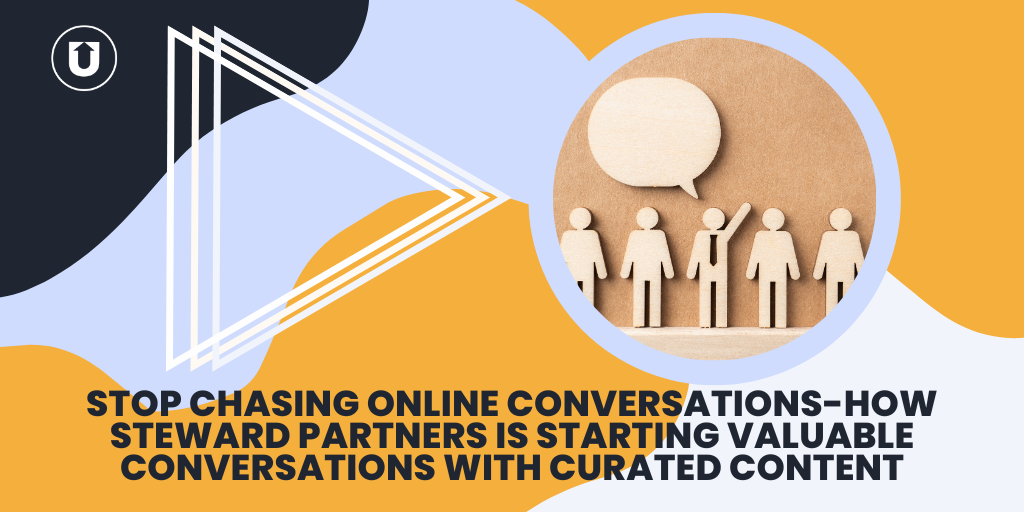Building Story Leadership Through Content Curation
The following captures the highlights from a discussion on The BrandTelling Podcast between Arthur Germain from Communication Strategy Group and Scott Rogerson of UpContent. The episode was titled "Building Story Leadership Through Content Curation."

Effective marketing is supported by powerful, actionable content. Content establishes authority.
It crystallizes and clarifies for your audience. It can position the organization delivering the content as an expert. It provides the audience with value, and in turn, enables the reader to associate that feeling of gaining value with the outlet delivering the content.
While producing original content is valuable and necessary in today's marketing landscape, it isn't the only way to deliver valuable insights to readers.
External content from other resources outside your organization can help your readers just as much as your own created content can.
If you consistently provide your readers with value-laden content from a variety of sources, they'll continually look to you as a source of information.
The question then becomes: how do you reliably find this content?
Let's take a closer look at why (and how) you should curate content in a way that will help you and your team build something known as "story leadership."
The content curation model
Let's say your team has come up with a winning marketing strategy. It's comprehensive and engaging, guaranteed to be successful with your desired customer base.
But what happens when your team may not have the skillset and/or resources required to execute that strategy?
That's where it helps to partner with an organization that understands how to do just that.
One of the key elements of successfully executing a marketing strategy effectively and efficiently involves the seemingly simple act of "finding stuff."
That's an easier way to say developing and identifying content that will resonate with your audience.
Often, teams can get stuck in silos, with multiple team members searching for content to supplement social media calendars, original content, understand the specific industry better, or provide material for emails.
Sometimes these team members, searching independently, may come across the same material or find material that conflicts in some way with other identified content.
In short, being a successful content curator means identifying the best way to find the right "stuff."
That's where you'll want the marketing team you work with to take a proactive posture in identifying content.
It's not enough to examine what articles worked well in the past. It's about working with a team to collaboratively identify articles that provide the best fit for what you want to achieve moving forward.
Building a better content curation tool
Marketing and technology go hand in hand in the current content curation landscape. Plenty of tools exist that aid in distribution.
But this does nothing to address the content itself. How can companies consistently and reliably find the content that's going to position them as a trusted resource in their chosen area of expertise?
In 2015, UpContent created a content discovery tool for internal use. Since that time, our team has found that there's a greater problem not unique to us.
Organizations and agency partners are all looking to discover the right content that helps them accomplish three main goals:
- Attract new customers. This means using content to draw potential new customers in.
- Win new customers. In this phase, companies are looking to appeal to the customers they've initially attracted by convincing them to take the next step.
- Retain existing customers. Once you've gotten someone's business, how do you keep it? How do you continually provide them value, keeping them coming back for more?
Content exists to help you accomplish all three of these goals. So that's why finding the right content becomes critical. Using a marketing automation application for this can help.
You'll also want to think about how you're going to present and implement all this content once you've found it.
How you can apply the "museum approach" to content curation
When many people hear the word "curate," an image of a museum comes to mind. They think of exhibits arranged strategically to convey a particular theme.
Curators make decisions on what pieces to put together and then put them on display for the public.
The idea of content curation in the marketing space is new, emerging over the last five years or so. Initially, people weren't taking a "museum approach" to curation.
They viewed it as a way to "fill up" on content and place a premium on frequency and volume.
These large amounts of content can now seem overwhelming in terms of providing audiences with the information they need to make decisions.
The most successful organizations are moving away from the model of "create as much as you can." Instead, they're focused on building a unique perspective reinforced by their curated content.
This perspective reflects an understanding of - and, in many cases, solutions for - problems faced by their customers.
Successful organizations write articles that discuss these unique perspectives. But writing these articles shouldn't be the only contribution of these organizations.
In every industry, there are a lot of good ideas floating around. Many of them already have content created around them.
This content can create a more clarified context for your organization's unique perspectives. If those pieces already exist, you don't need to write them - and in many cases, you shouldn't be writing them.
Don't look at curating content from other sources explicitly as a way to highlight the work other people are doing.
Look at it as a way to say, "Don't just take our word for it." Your audience can read your original content then also validate it by reading the original content from other sources. You serve as a conduit for that content, delivering it to your audience.
Valuable information is valuable information, whether it comes from you or someone else. Here, you're providing your audience with it while also reinforcing your expertise and viewpoints at the same time.
You can share your perspective with your audience through your social media channels or your email newsletter.
Think of this as building your personal content museum. At a museum, you can get a feel for a story by simply looking at the pieces without reading the individual plaques.
That's because the works are presented together to evoke a specific sensation or feeling.
Working in a brand, you need to approach curation that way. You don't need to write six paragraphs providing your take on an article.
Instead, you can focus on highlighting the article itself, and telling your audience that it's something they need to read. Take away the excess commentary.
You're not taking attention away from or removing your original content. You're driving traffic to it using another external article, sharing your perspective with the audience.
How to use story leadership
The term "thought leadership" is often thrown around in marketing, but having a thought and then sharing that thought is not always useful for your audience.
There's another kind of leadership you'll want to focus on where you curate the information from your organization and other organizations to share stories that align with where you're moving.
It helps communicate the direction you want to take your clients and customers. This is called story leadership.
Many thought leaders tend to focus on the content they produce without any additional content added for insight.
But think about it in terms of education. If you left elementary school children to learn everything themselves versus learning from themselves along with learning from others, it would take them much longer to grasp the core concepts needed.
Story leadership is a form of thought leadership where you move beyond simply providing your thoughts. You become a publisher, weaving your ideas in with the ideas of others to tell a coherent, effective story.
Your target audience member must distinguish between your thoughts and the thoughts of others within your space.
They must determine the context of those ideas and concepts. What's the evidence supporting your ideas?
When a member of your audience reads your content, how do they know they can trust that you'll not only have good thoughts today but that you'll also guide them in the right direction going forward?
Story leadership helps you curate content by showing your audience that other stories exist to highlight and reinforce your ideas.
Using content curation to establish your organization as a trusted resource
When your audience looks to you as a content provider, you're establishing a level of trust between them and your organization.
They can work with technology integration and agency partners like MailChimp, HubSpot, and HootSuite to deliver valuable content from their industry.
Those teams provide the infrastructure needed to disseminate the messaging. But it doesn't address the need for actual content input.
UpContent helps their partners stay on top of what's happening within both their industry and the world of marketing.
If you're looking at a more reliable way to find the right content for your audience, UpContent may be the right partner for you.
We have a short video available demonstrating our process for finding and selecting the best articles, connecting with the distribution tools you're using.
You can also schedule a demonstration for a more in-depth discussion about your specific goals and needs. For more on how we can help you revolutionize your content curation, book a demo today.
Image Credit:
"Prioritizing user stories" by jakuza is licensed under CC BY-SA 2.0



